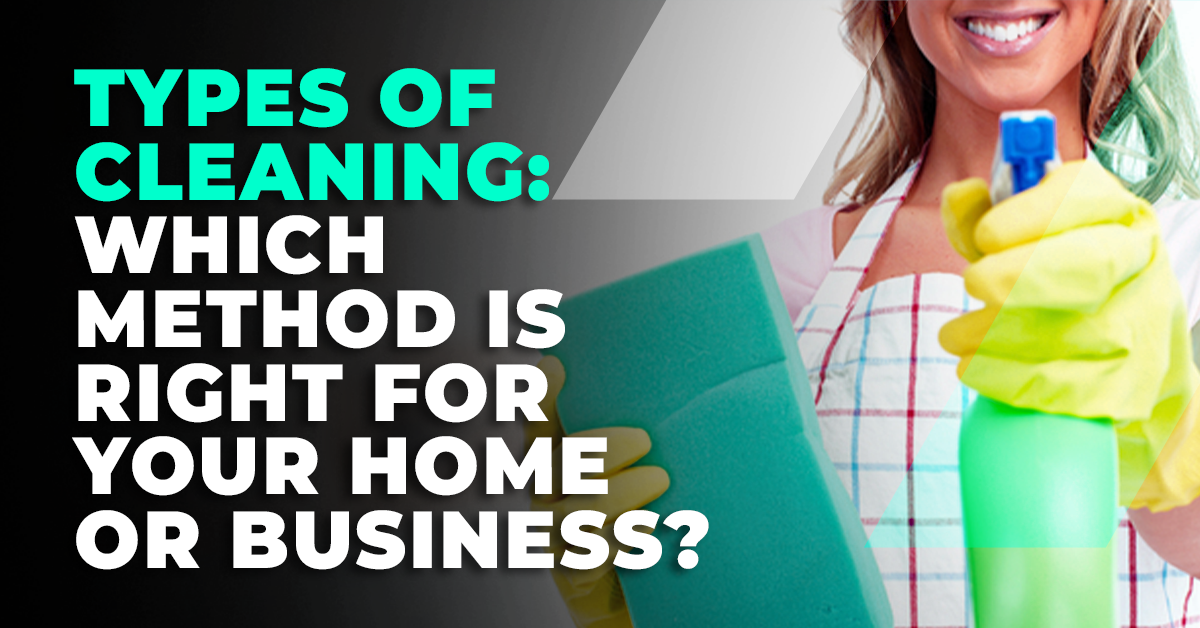Licensed And Insured

Types of Cleaning services: Which Method is Right for Your Home or Business?
A clean workplace can lead to a 5% increase in employee productivity. Additionally, 94% of consumers are more likely to avoid a business with dirty restrooms. These statistics highlight the importance of maintaining a clean home or business for personal and professional reasons.
We all know how important it is to keep a clean and organized home, but have you ever considered the impact that cleanliness could have on your business? Likewise, the benefits of a clean and well-maintained workplace are undeniable, from improving employee productivity to attracting and retaining customers.
However, with so many cleaning methods available, it can take time to determine which one is right for your specific needs. Many options exist, from traditional cleaning methods to modern, eco-friendly alternatives.
In this blog post, we’ll explore the different types of cleaning methods available and help you decide which one is best suited for your home or business. So whether you’re looking for a deep clean, a regular maintenance cleaning, or a specialized service, we’ve got you covered.
Types of Cleaning: Which Method Is Right for Your Home or Business?
Several types of cleaning methods are available, each with unique benefits and applications. Here are some common types of cleaning:
1. Residential Cleaning
Residential cleaning is a type of cleaning service specifically tailored to meet the needs of homeowners. It involves cleaning residential spaces like apartments, condos, and houses.

There are different types of residential cleaning services, including-
- Regular Cleaning: Regular Cleaning is a type of residential cleaning involving routine cleaning of your home. This includes dusting, vacuuming, mopping, and wiping surfaces. It is a recurring service that can be scheduled weekly, bi-weekly, or monthly, depending on your needs.
- Deep Cleaning: Deep cleaning is a more thorough type of cleaning involving cleaning areas often neglected during regular cleaning. It includes cleaning inside ovens, refrigerators, and other appliances, scrubbing walls, baseboards, and cleaning carpets. It is recommended to do this type of cleaning once or twice a year to maintain a healthy living environment.
- Move-in/move-out Cleaning: Move-in/move-out Cleaning is a type of residential or house cleaning service typically performed when moving in or out of a home. This type of cleaning involves a more thorough cleaning of the entire house, including cabinets, drawers, closets, and other storage areas. This ensures the home is ready for the next occupants or your move-in.
- Post-construction Cleaning: Post-construction Cleaning is a specialized type of cleaning that involves the removal of dust, debris, and other construction-related messes from home after construction or remodeling. It is usually performed before a final walk-through or inspection to ensure the house is clean and ready for occupancy.
Popular Cleaning Methods and Tools Used in Environmental Cleaning:
Environmental cleaning requires specialized tools and techniques to remove hazardous waste safely and effectively.
Personal protective equipment (PPE), including gloves, goggles, and respirators, is essential for protecting the cleaners from exposure to hazardous materials. Decontamination is removing hazardous materials from surfaces, equipment, and other items. Disinfection is the process of killing bacteria, viruses, and other pathogens on surfaces.
2. Commercial cleaning
Industrial cleaning involves using specialized techniques and equipment to clean and maintain various industrial facilities. It is critical to ensure that these facilities are kept clean and safe to avoid accidents and maintain a healthy working environment for employees.

Here are the different types of commercial or office cleaning –
- Manufacturing Cleaning: This cleaning involves Cleaning and maintaining manufacturing facilities, including machinery and equipment.
- Warehouse Cleaning: Warehouses are prone to dust and debris buildup, making regular cleaning and maintenance necessary. This cleaning involves dusting, sweeping, and mopping floors and surfaces.
- Construction Site Cleaning: This type of cleaning occurs during and after construction to ensure that the site is clean and safe for workers.
- Oil and Gas Cleaning: This type of cleaning involves the maintenance of oil and gas facilities, which can be hazardous if not appropriately cleaned and maintained.
- Kitchen Cleaning: While the above types of industrial cleaning are essential, it’s worth noting that kitchen cleaning is also a vital aspect of commercial cleaning. Kitchens in industrial settings, such as factories or warehouses, require regular cleaning to prevent contamination and ensure food safety.
Professionals can provide specialized kitchen cleaning services using commercial-grade equipment and environmentally friendly products to ensure a clean and safe working environment.
Popular Cleaning Methods and Tools Used in Industrial Cleaning:
- Pressure Washing involves using high-pressure water jets to clean surfaces such as floors, walls, and machinery.
- Chemical cleaning involves using chemicals to dissolve dirt and debris on surfaces.
- Steam Cleaning involves high-pressure steam to clean surfaces and remove dirt and grime.
- Sandblasting involves using high-pressure sand or other abrasive materials to clean surfaces.
- Scrubbing: This involves using specialized equipment to scrub and clean surfaces thoroughly.
3. Environmental Cleaning
Environmental cleaning is an essential service that involves the removal of hazardous waste, biohazards, and crime scenes to maintain public health and safety. Environmental cleaning is a specialized service that requires trained professionals with specific expertise and equipment.

There are various types of environmental cleaning services available, including –
- Hazardous waste cleaning: Hazardous waste cleaning removes harmful substances, such as chemicals, pesticides, and radioactive materials.
- Biohazard cleaning: Biohazard cleaning involves the removal of biological waste, such as blood, bodily fluids, and medical waste.
- Crime scene cleaning: Crime scene cleaning removes biohazardous waste from a crime scene.
Popular Cleaning Methods and Tools Used in Environmental Cleaning:
Environmental cleaning requires specialized tools and techniques to remove hazardous waste safely and effectively. In addition, personal protective equipment (PPE), including gloves, goggles, and respirators, is essential for protecting the cleaners from exposure to hazardous materials.
Decontamination is removing hazardous materials from surfaces, equipment, and other items. Disinfection is the process of killing bacteria, viruses, and other pathogens on surfaces.
Wrapping UP
Choosing the correct cleaning method for your home or business can make all the difference in maintaining a clean and healthy environment. Depending on your specific needs, various options are available, from residential to industrial and environmental cleaning.
At Spotless Magic World, we offer a wide range of cleaning work or services tailored to meet the unique requirements of our clients. Our professional and experienced cleaners use the latest methods and tools to ensure your space is spotless and sanitized, giving you peace of mind knowing that your space is professionally cleaned.
FAQs
Q. What are the 3 Types of Cleaning?
The three types of cleaning are –
- Residential cleaning,
- Industrial Cleaning, and
- Environmental Cleaning
Q. What are Basic Cleaning Methods?
Basic cleaning methods typically include dusting, sweeping, mopping, vacuuming, and wiping down surfaces. These methods remove surface dirt, dust, and debris from floors, walls, furniture, and other areas. Basic cleaning is usually done regularly to maintain cleanliness in a space.



